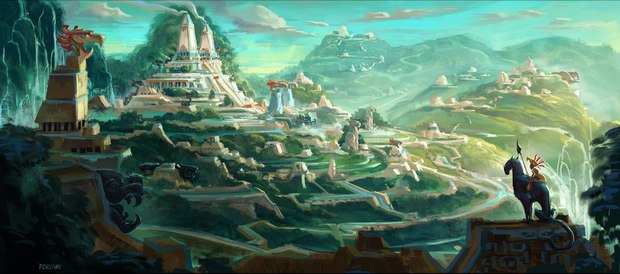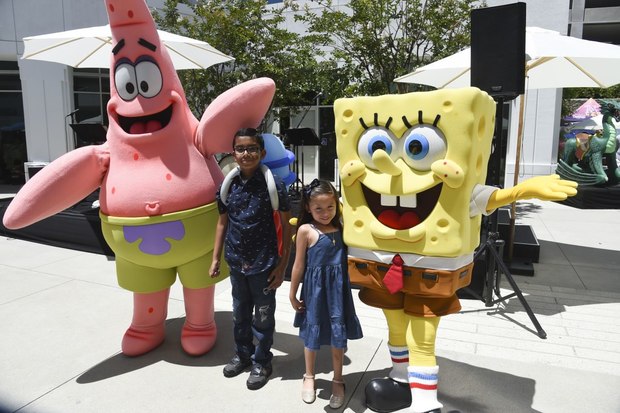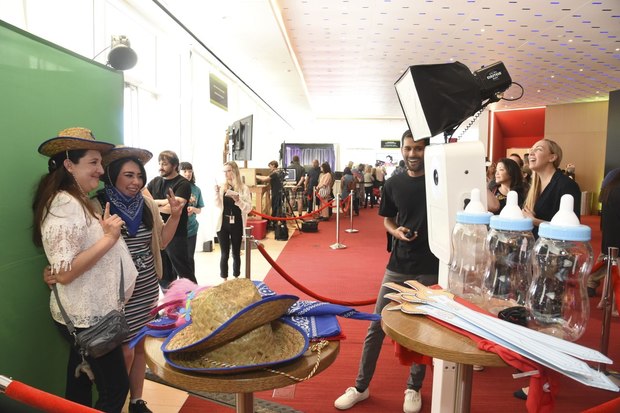The ‘Son of Jaguar’ and ‘The Book of Life’ director takes center stage at TV Academy diversity in animation celebration to wow the crowd with his uplifting story of a career spent fighting against all odds.
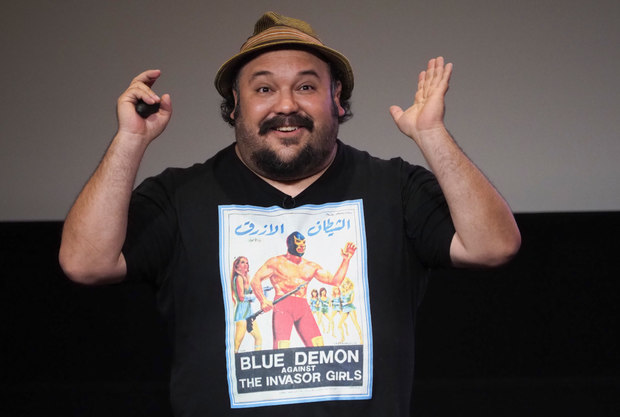 As the featured speaker at the June 29 TV Academy “It's Not Just a Cartoon 2019: A Celebration of Diversity in Animation” gathering, animation director Jorge Gutierrez (The Book of Life, Son of Jaguar) shared a career-full of heartbreaking but ultimately uplifting stories where time and time again, he kept his head down and chin up while pushing onward against all manner of adversity. If you’ve never had a chance to meet him, I encourage it; you’ll never meet a nicer, more gracious and humble person. Or prolifically talented artist. If you’ve never had a chance to hear him speak, you’re in for a rare treat if one day you can. His knowledge and insight into the often-brutal business of animation, coupled with his ability to capture an audience through spellbinding storytelling, is extraordinary. As expected, his presentation thrilled the packed Wolf Theatre crowd at the Saban Media Center.
As the featured speaker at the June 29 TV Academy “It's Not Just a Cartoon 2019: A Celebration of Diversity in Animation” gathering, animation director Jorge Gutierrez (The Book of Life, Son of Jaguar) shared a career-full of heartbreaking but ultimately uplifting stories where time and time again, he kept his head down and chin up while pushing onward against all manner of adversity. If you’ve never had a chance to meet him, I encourage it; you’ll never meet a nicer, more gracious and humble person. Or prolifically talented artist. If you’ve never had a chance to hear him speak, you’re in for a rare treat if one day you can. His knowledge and insight into the often-brutal business of animation, coupled with his ability to capture an audience through spellbinding storytelling, is extraordinary. As expected, his presentation thrilled the packed Wolf Theatre crowd at the Saban Media Center.
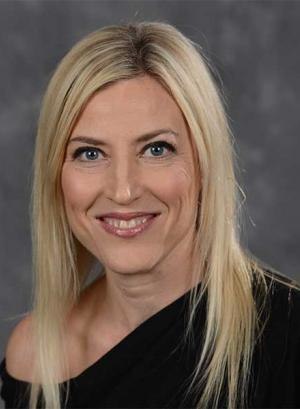 The well attended afternoon event, an “open house” if you will, featuring various demonstrations and booths where attendees could try their hand at activities like voice recording or checking out real-time VR painting technology, was packed with industry folks, exuberant kids and their families. According to Jill Daniels, Governor to the Academy for Animation and chair of the Academy Activities Committee, she’s been working to bring more animation-related events to the organization for some time. “I had been a member for a few years, and I didn't see a lot of events happening that were really specifically geared for animation,” she shares. “So, when I came in, that was a really important part of what I wanted to have my time as a Governor be about. And the Academy said that they were looking to have a whole new format for events. They wanted to do things that were more of a deep-dive into animation, not just events centered on things like FYC consideration.”
The well attended afternoon event, an “open house” if you will, featuring various demonstrations and booths where attendees could try their hand at activities like voice recording or checking out real-time VR painting technology, was packed with industry folks, exuberant kids and their families. According to Jill Daniels, Governor to the Academy for Animation and chair of the Academy Activities Committee, she’s been working to bring more animation-related events to the organization for some time. “I had been a member for a few years, and I didn't see a lot of events happening that were really specifically geared for animation,” she shares. “So, when I came in, that was a really important part of what I wanted to have my time as a Governor be about. And the Academy said that they were looking to have a whole new format for events. They wanted to do things that were more of a deep-dive into animation, not just events centered on things like FYC consideration.”
For Daniels, the Celebration event was about more than just showcasing interesting facets of animation production. It shed light on and explicitly supported more recent industry efforts to address various aspects of workplace diversity and inclusion. “This event is really about how no matter your race, your age, or your sex, as creatives, we're all one community,” she added. “And I think that's such a huge, huge thing. Animation is a real gift to humanity. So, it makes sense to spotlight a sense of diversity, of really being in touch with humanity to show we are all one community.”
Before Gutierrez took the stage to talk about his career ups and downs, the seemingly insurmountable challenges he has faced since getting accepted to Cal Arts as a non-English speaking 17-year-old from Tijuana, and his love for Mexican folk and pop culture, we sat down to talk about industry diversity, career perseverance and his new Netflix project, Maya and the Three, set for a summer 2021 release, which as he briefly teased on stage, is an epic fantasy about a Mesoamerican heroine, a warrior princess, along the lines of a Mexican Lord of the Rings.
Dan Sarto: So, what are you working on these days?
Jorge Gutierrez: Man, I am living in heaven at Netflix. I can’t talk about the project officially, but it’s an epic story along the lines of a Mexican Lord of the Rings, but based on a Mesoamerican warrior princess. Right now at Netflix, it’s crazy. I feel like it's a magical time. We're not going to see the fruits for a while, but the stuff that's cooking is crazy over there.
DS: There is an unprecedented amount of animation being produced at Netflix right now.
JG: Yeah, and those are just the projects that have been announced. You see the people that they're signing and already have on board, it feels like the Justice League over there. It's just crazy.
DS: It’s nice to see you land somewhere that has the patience to allow you to work your magic.
JG: For sure. And for me, the thing that's most notable, that most different, has been that Netflix's audience is the world. So, projects are no longer just for the US and let's hope it works outside the US. Now the world is the audience and it'd be cool if it works in the US. I've never had that in my career. So, that's been a giant change in the way I approach stuff. I feel like I’ve gotten a second chance, like I've been reborn in a weird way.
DS: Well, you’ve certainly put in your dues. Animation is such a brutal artistic medium anyways, so everybody who stays in it is a survivor of sorts.
JG: Very true.
DS: We’ve spoken many times, and I’ve sat through several of your presentations over the years, at events in a number of countries, and I’m always enthralled by how you speak so eloquently, so honestly and with such humor about your travails and the adversity you’ve faced in your career.
JG: And the failures. I owned those.
DS: And shared them in gripping but hilarious detail. But there’s a common thread to all of it and that is that as a creator, as a storyteller, you're always swimming upstream to get your vision onto the screen. You’re the perfect person to speak at an event like this focused on diversity and inclusion in the animation industry.
JG: My God, I'm super honored to be here at the TV Academy. I was actually an Emmy intern… a TV Academy intern. That was my first taste of the world of animation. Then I got super lucky and won a Student Emmy, which pretty much changed my career, Years later, I won an Emmy for El Tigre. The TV Academy has always been there for me. They undertook an initiative back then to help people of color and women and I hope those seeds that they helped plant are all blossoming. So, I'm really thankful.
DS: TV and streaming now seem to provide the best opportunities for diverse voices in animation, more so than features. You cut your teeth in the TV world. How does that experience help you in the world of features?
JG: A lot of my heroes cut their teeth in TV, right? Brad Bird, Rich Moore, Chris and Phil [Miller and Lord], all these guys. If you really study their careers… all the people that I really admire went through TV. When you get to features having gone through the gauntlet of television, you're way more focused, you know what you need and you know what you don't need. And I think that got me a lot more ready. And now that I'm in the world of streaming, I'm not doing a TV show and I'm not doing a movie. I'm doing a limited series, right?
My favorite thing about movies is that you tell these grandiose, giant, epic stories. But, they're 83 minutes long. That's it. My favorite thing about TV was trying out new things. But, your characters can't really change. Like, SpongeBob can't change from one episode to the other, it's got to be the same SpongeBob. So, the character arcs are not internal, they're external. So how do you get both? Limited series! You can pick four and a half hour stories with full character arcs, full worlds to explode. Before the streaming world came about, I couldn't do that anywhere. I would just be jealous of live-action and other mediums that allowed those things. But, because of the limitations of what studios were willing to do, we weren't even allowed to dream about that stuff. And now we are.
DS: With regards to the more recent attention paid in the press, and consequently, at the studio executive level, with regards to issues surrounding diversity and inclusion, do you see more than lip service being paid to the need for workplace and industry change?
JG: For some people it appears to be quite heartfelt, for others you might say there’s a bit of lip service. But, for some, even that’s a start. By the way, I'd rather have lip service than nothing.
DS: Absolutely, which is why it's important to keep writing, presenting and talking about these issues because it keeps it fresh and topical. What are some of the things you hope to see moving forward? You say that you've benefited yourself from industry attention being paid to bringing in diverse voices. What do you hope happens? What do you want to see expanded with regards to opening up more business opportunities, both from a project standpoint as well as from an executive standpoint… from both a creative and business decision-making standpoint?
JG: To me, the real needle mover in Hollywood is money. When a film like Black Panther or Wonder Woman becomes a financial success, that changes things, right? When Shonda Rhimes becomes an empress of television, or Ryan Murphy becomes one of the biggest producers in the world and you start getting these diverse voices creating shows that are not only critically acclaimed but commercially successful, that to me speaks volumes as to why we should be diverse. Because the way Hollywood works, no one's going to do things just for the good of it, it's got to be for the good of it and let's make sure it makes a ton of money. That’s what really moves the needle and justifies taking risks… someone taking a chance on a person of color or a woman and going, “Okay, let’s see if this works.”
Normally, execs say, “Well this person did this before, so the risk of that person messing up is minimal.” Well, if you're going with new people then there's no reference, right? It’s risky. So, taking that chance, that's where the magic happens.
Every diversity panel I'm on, I always say, “Everybody who's here in the room, you’re already pro-message. We're already preaching to the choir. We’ve got to convince the people who are not here.” And the only way we're going to convince them is by showing them, “Look how much money you're leaving at the table if you're not pushing for diversity!”
DS: Do you think that folks like Netflix, with such a huge world audience, are making the biggest strides with regards to telling diverse stories from diverse storytellers, because all of these different audiences, who wouldn't necessarily get access to those stories, now can?
JG: You hit it on the nail, by the way. You make a commercial film for one of the major studios and it's going to cost at least $100 million… they're going to spend another $100 million on marketing, so you're $200 million in. That means the movie has to be commercial enough from the very beginning, conceived in a way where they're going to get their money back. With Netflix, the approach is different. They say, “If only Guillermo del Toro fans watch the animated Pinocchio worldwide, we're going to be OK.” So now, Guillermo can do his version of a movie and it doesn't have to appease this giant commercial expectation. With Henry Selick's new movie, there's enough Henry Selick lovers in the Netflix audience that love all his films, that if all those people love his new film, that justifies that expense. So, it's like these giant massive niche audiences are now enough to justify the risk of production. That’s why we're seeing more adult animation, with themes that are more edgy. Look at the rebirth of 2D animation, right? Sergio Pablos with Klaus. We are witnessing, I believe, the 3rd coming of 2D animation, and who knew a Spaniard who went to Cal Arts would be the one who raises the flag. That couldn't have happened without streaming.
DS: Last question. For all the young creatives, the young professionals, the folks that are out there who more than anything in the world want to do what you do, but who don’t know the industry and only see barriers to their entry and acceptance… what advice do you have for them?
JG: The advice I give, which is something that I did myself, is study the people you admire, study their path, study how they got to where they got, study where they started and where they are now. Because when you see that ladder, the path they took, the ups and downs, how for many years it was only downs before it went up again, you start to realize, “Oh, no one's born and then just given a movie or a TV show. They've gone through a lot of stuff' to get to that point.”
Literally I would say, “OK, where did Brad Bird start? Where did Tim Burton start? Where did Henry Selick start? They started here? Well I can get to where they started. I'm not going to get to where they are now, but I can get to where they started and figure out how to move forward from there.” Obviously, its going to be difficult and hard for everybody. But, that's part of the process. And if you fall in love with the success, you're not seeing the path. The path is going to be long and arduous, but that's what's going to make you good.
Dan Sarto is Publisher and Editor-in-Chief of Animation World Network.
